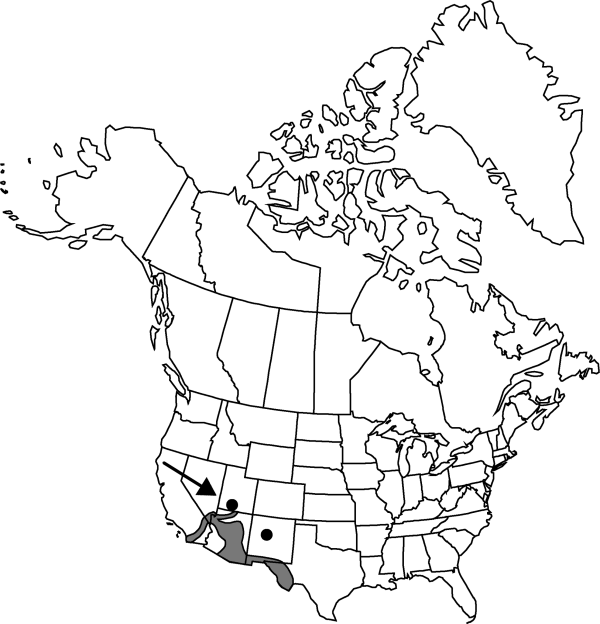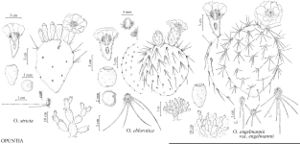Difference between revisions of "Opuntia engelmannii var. engelmannii"
FNA>Volume Importer |
imported>Volume Importer |
||
| (7 intermediate revisions by 2 users not shown) | |||
| Line 1: | Line 1: | ||
{{Treatment/ID | {{Treatment/ID | ||
|accepted_name=Opuntia engelmannii var. engelmannii | |accepted_name=Opuntia engelmannii var. engelmannii | ||
| − | |accepted_authority= | + | |accepted_authority= |
|publications= | |publications= | ||
|common_names=Engelmann’s pricklypear | |common_names=Engelmann’s pricklypear | ||
| + | |special_status={{Treatment/ID/Special_status | ||
| + | |code=F | ||
| + | |label=Illustrated | ||
| + | }} | ||
|basionyms= | |basionyms= | ||
|synonyms={{Treatment/ID/Synonym | |synonyms={{Treatment/ID/Synonym | ||
|name=Opuntia dillei | |name=Opuntia dillei | ||
|authority=Griffiths | |authority=Griffiths | ||
| − | }}{{Treatment/ID/Synonym | + | |rank=species |
| + | }} {{Treatment/ID/Synonym | ||
|name=Opuntia discata | |name=Opuntia discata | ||
|authority=Griffiths | |authority=Griffiths | ||
| − | }}{{Treatment/ID/Synonym | + | |rank=species |
| + | }} {{Treatment/ID/Synonym | ||
|name=Opuntia phaeacantha var. discata | |name=Opuntia phaeacantha var. discata | ||
| − | |authority= | + | |authority= |
| + | |rank=variety | ||
}} | }} | ||
|hierarchy=Cactaceae;Cactaceae subfam. Opuntioideae;Opuntia;Opuntia engelmannii;Opuntia engelmannii var. engelmannii | |hierarchy=Cactaceae;Cactaceae subfam. Opuntioideae;Opuntia;Opuntia engelmannii;Opuntia engelmannii var. engelmannii | ||
| Line 22: | Line 29: | ||
}}<!-- | }}<!-- | ||
| − | --><span class="statement" id="st- | + | --><span class="statement" id="st-undefined" data-properties=""><b>Stem </b>segments circular to obovate to rhombic, 20–40 × 17–30 cm, to 1.5 times longer than wide. <b>Spines</b> (0–)1–5(–12) per areole, absent or at most areoles, chalky white, yellow when wetted, aging gray to black, usually with red-brown extreme bases, longest 20–50(–75) mm. <b>2n</b> = 66.</span><!-- |
-->{{Treatment/Body | -->{{Treatment/Body | ||
| + | |phenology=Flowering spring (Apr–Jul). | ||
|habitat=Deserts, grasslands, woodlands, plains, sandy soils to rocky hillsides, lower to midslopes of mountains | |habitat=Deserts, grasslands, woodlands, plains, sandy soils to rocky hillsides, lower to midslopes of mountains | ||
|elevation=300-2700 m | |elevation=300-2700 m | ||
|distribution=Ariz.;Calif.;Nev.;N.Mex.;Tex.;Utah;Mexico. | |distribution=Ariz.;Calif.;Nev.;N.Mex.;Tex.;Utah;Mexico. | ||
| − | |discussion=<p>In Arizona, California, and New Mexico, Opuntia engelmannii var. engelmannii hybridizes with O. phaeacantha yielding numerous named and unnamed hexaploid forms, including O. wootonii Griffiths; the various intermediates have 2n = 66. Hybrid swarms occur in both Zion and Grand Canyon national parks; these plants were perhaps brought in to the parks by native peoples as a food source and they are associated with agaves also believed to have been imported.</p> | + | |discussion=<p>In Arizona, California, and New Mexico, <i>Opuntia engelmannii </i>var.<i> engelmannii</i> hybridizes with <i>O. phaeacantha</i> yielding numerous named and unnamed hexaploid forms, including O. wootonii Griffiths; the various intermediates have 2n = 66. Hybrid swarms occur in both Zion and Grand Canyon national parks; these plants were perhaps brought in to the parks by native peoples as a food source and they are associated with agaves also believed to have been imported.</p> |
|tables= | |tables= | ||
|references= | |references= | ||
| Line 37: | Line 45: | ||
-->{{#Taxon: | -->{{#Taxon: | ||
name=Opuntia engelmannii var. engelmannii | name=Opuntia engelmannii var. engelmannii | ||
| − | + | |authority= | |
| − | |authority= | ||
|rank=variety | |rank=variety | ||
|parent rank=species | |parent rank=species | ||
| Line 44: | Line 51: | ||
|basionyms= | |basionyms= | ||
|family=Cactaceae | |family=Cactaceae | ||
| + | |phenology=Flowering spring (Apr–Jul). | ||
|habitat=Deserts, grasslands, woodlands, plains, sandy soils to rocky hillsides, lower to midslopes of mountains | |habitat=Deserts, grasslands, woodlands, plains, sandy soils to rocky hillsides, lower to midslopes of mountains | ||
|elevation=300-2700 m | |elevation=300-2700 m | ||
| Line 50: | Line 58: | ||
|publication title= | |publication title= | ||
|publication year= | |publication year= | ||
| − | |special status= | + | |special status=Illustrated |
| − | |source xml=https:// | + | |source xml=https://bitbucket.org/aafc-mbb/fna-data-curation/src/2e0870ddd59836b60bcf96646a41e87ea5a5943a/coarse_grained_fna_xml/V4/V4_253.xml |
|subfamily=Cactaceae subfam. Opuntioideae | |subfamily=Cactaceae subfam. Opuntioideae | ||
|genus=Opuntia | |genus=Opuntia | ||
|species=Opuntia engelmannii | |species=Opuntia engelmannii | ||
|variety=Opuntia engelmannii var. engelmannii | |variety=Opuntia engelmannii var. engelmannii | ||
| − | |||
| − | |||
| − | |||
| − | |||
| − | |||
| − | |||
| − | |||
| − | |||
| − | |||
| − | |||
| − | |||
| − | |||
}}<!-- | }}<!-- | ||
-->[[Category:Treatment]][[Category:Opuntia engelmannii]] | -->[[Category:Treatment]][[Category:Opuntia engelmannii]] | ||
Latest revision as of 21:57, 5 November 2020
Stem segments circular to obovate to rhombic, 20–40 × 17–30 cm, to 1.5 times longer than wide. Spines (0–)1–5(–12) per areole, absent or at most areoles, chalky white, yellow when wetted, aging gray to black, usually with red-brown extreme bases, longest 20–50(–75) mm. 2n = 66.
Phenology: Flowering spring (Apr–Jul).
Habitat: Deserts, grasslands, woodlands, plains, sandy soils to rocky hillsides, lower to midslopes of mountains
Elevation: 300-2700 m
Distribution

Ariz., Calif., Nev., N.Mex., Tex., Utah, Mexico.
Discussion
In Arizona, California, and New Mexico, Opuntia engelmannii var. engelmannii hybridizes with O. phaeacantha yielding numerous named and unnamed hexaploid forms, including O. wootonii Griffiths; the various intermediates have 2n = 66. Hybrid swarms occur in both Zion and Grand Canyon national parks; these plants were perhaps brought in to the parks by native peoples as a food source and they are associated with agaves also believed to have been imported.
Selected References
None.
